大曲の花火の歴史 Omagari Hanabi History
コンテンツ番号:152
更新日:
余興花火から日本一の花火大会へ History
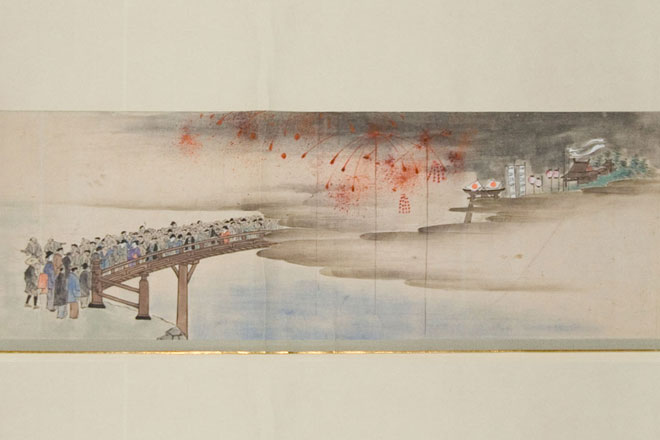
「大曲村年中行事絵巻物(諏訪神社蔵)」"Omagari Village Annual Ceremony Scroll – Suwa Shrine”
「大曲の花火」の歴史は古く、江戸時代のころまでさかのぼるとされていますが、藩政期から明治初期を通じての大曲の花火に関する資料は多くありません。
文献上で大曲に花火らしきものが初めて登場するのが、文化・文政期(1800年初期)に菅江真澄が書いた地誌「月の出羽路」に描かれている民俗行事「大曲ノ郷の眠流」の挿絵です。挿絵には丸子橋の上を行く眠り流しの灯ろうとともに、後方の川原で打ち上げられている花火が描かれています。
また、上大町の諏訪神社が所蔵する、市指定の有形歴史文化財で明治初年の作と推定される「大曲村年中行事絵巻物」(中央写真)には祭典風景が描かれ、その中に花火の打ち上げの様子が登場します。
もちろん、藩政時代から秋田にも花火は広く普及していましたが、仙北平野の米産地の中心地に加え、雄物川につながる丸子川の川港を中心とした周辺には豪商が軒をつらね、歓楽街、繁華街が形成されていった大曲でも、まちの発展に伴い花火需要も多くなり、行事や祭りには欠かせない存在となったことは推測できます。
Said to date back as far as the Edo period, the history of Omagari Hanabi runs deep despite there being very little documentation between the feudal era and the early Meiji period.
Hanabi in Omagari makes its first literary appearance within the illustration of the folk festival Omagari Village Nemurinagashi depicted in Masumi Sugae’s topography Dewa Road Moon from the early 1800s. The illustration shows lanterns passing over Maruko Bridge to reinvigorate tired summer bodies while hanabi are fired along the riverbed in the distance.
Hanabi can also be seen as part of a ceremony depicted within the Omagari Village Annual Ceremony Scroll (centre image), a tangible cultural property of the early Meiji period which is stored at Suwa Shrine in Kamiomachi and designated by the city for its historical significance.
Hanabi have been very prominent in Akita since the feudal era, and it is thought that the central granary region of the Senboku Plains supported by the port along Maruko River which feeds into the Omono was a significant factor, driving the economy and in turn demand for ceremonies and festivals in Omagari’s thriving entertainment and downtown districts.
花火伝来伝説 Hanabi Legend
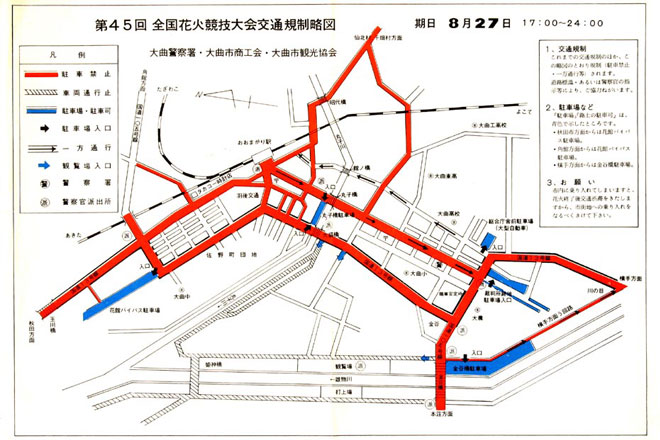
大仙市には花火伝来に関する資料はありませんが、隣町の六郷(美郷町)には花火伝来の伝説があります。
天下分け目の戦といわれた関ヶ原の戦い(1600年)で敗れた豊臣方に組みしたとみられた初代の秋田藩主佐竹義宣は、常陸国(現在の茨城県)から秋田に国替えを命ぜられました。秋田へ向かう途中、あいにく連日の雨で雄物川が洪水となり、しばらく六郷に滞在することとなりました。この一行に若い火術家がいて、滞在中の部落の娘と恋に落ち入り部落内に身を隠しました。この火術家が部落に秘伝を伝え、後に生計のために、この秘伝を生かして花火を製造したのが、この地の花火の発祥といわれています。
Although there are no records in Daisen that reference legends, nearby Rokugo (Misato Town) does have such documents.
Loyal to the Toyotomi Clan who lost the decisive Battle of Sekigahara (1600), the first daimyo of the Akita Domain, Yoshinobu Satake, was ordered to relocate to Akita from Hitachi Province (modern Ibaraki Prefecture). Due to persistent rains on the road to Akita which lead to the flooding of the Omono River, the company spent a prolonged period in Rokugo. Among them was a pyrotechnician who fell in love with a local girl and remained in the village in secret. It’s said that after sharing his craft with the village he then went on to produce hanabi as a living, leading the area to become known as the origin of hanabi.
祭典と花火 Ceremony & Hanabi
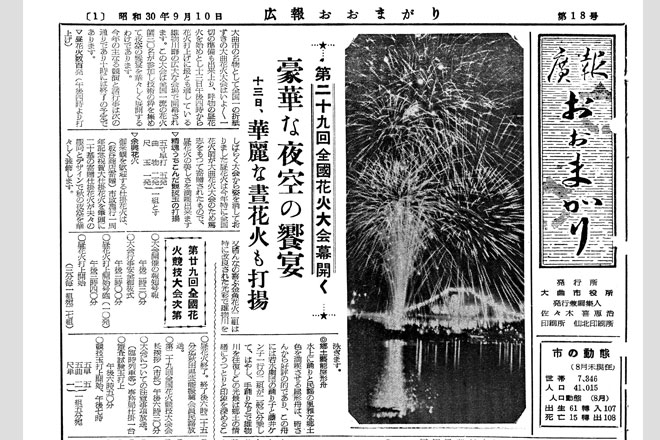
神社の祭礼と花火は切り離すことのできない存在ですが、大曲も例外ではありません。昔から花火好きの多いことでも知られる大曲では、諏訪神社の祭礼で花火を打ち上げました。昔は祭礼時に花火を奉納する人もいて「奉納する人たちの家々の前で花火を打ち上げた」という記録が残ります。現在でも、神社の神輿巡幸の道筋にあわせて打ち上げられる花火は、「神輿がきたぞ」という合図でもあり、町内からの花火の奉納でもあります。
Omagari is no exception to the rule that shrine ceremonies and hanabi are tightly intertwined. In Omagari, known for its many hanabi fans since long ago, hanabi were fired at the Suwa Shrine ceremony. In the past people would make offerings of hanabi at the ceremony, and records state that they were then fired in front of contributing houses. In the present day, offerings of hanabi from the town are fired on the portable shrine procession route, functioning as a signal that the shrine has arrived.
全国花火競技大会のはじまり National Fireworks Competition Origins
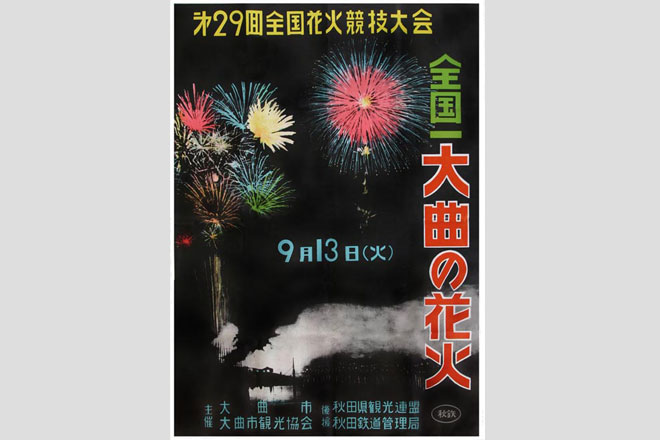
諏訪神社の祭典とのかかわりが深い奉納花火や余興花火が、明治43年(1910年)には「第1回奥羽六県煙火共進会」として開催されました。これが全国花火競技大会のはじまりです。
当時、東北で有名な花火師が一か所に集まり、花火の打ち上げをすることはほかに例がなく、画期的な催し物であったとされています。
The offerings and displays of hanabi that were an integral part of the Suwa Shrine ceremony eventually evolved into the first Ou Rokken Enka Kyoshinkai in 1910. This marked the beginning of the National Fireworks Competition.
Many famous hanabi artists gathered in Tohoku, making for a monumental event during a time when hanabi displays were still uncommon in other areas.
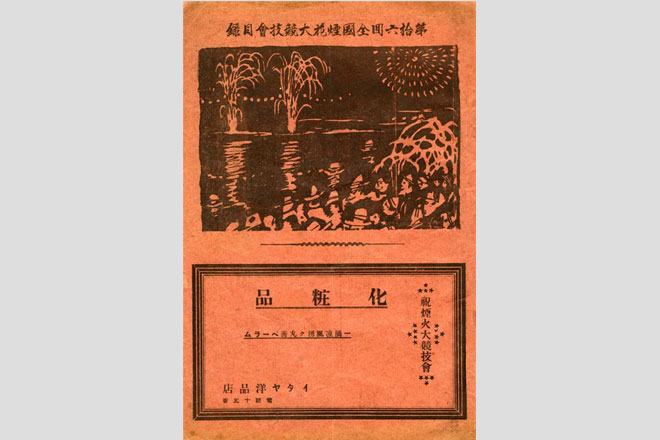
奥羽六県煙火共進会と花火先進地であった三河国(現在の愛知県)花火共進会が同時に開催されたことで、そこに参加した花火師は先進地三河の進歩した技術に驚き、その技術の習得に競って励んだことが大曲の花火の礎となったと考えられています。
以後、第3回までこの奥羽六県煙火共進会という形で開催され、大正4年(1915)の第4回大会からは「全国煙火競技大会」と名称を変え、名実ともに全国的な規模の花火大会へと発展。その後、戦争などで一時中断がありましたが、昭和21年(1946)終戦とともに、現在の「全国花火競技大会」として再開されました。大会は、敗戦による混乱の中の人々に大きな勇気と希望を与えました。終戦の翌年に花火大会を企画したことからも、大曲の人たちが、いかに花火好きなのかが分かります。
The Ou Rokken Enka Kyoshinkai was held together with the Mikawa Province (modern Aichi Prefecture) Hanabi Kyoshinkai. Participating hanabi artists were astonished by Mikawa’s advanced technique, and it is thought that competing to master these techniques became the foundation for Omagari Hanabi.
Going forward, the Ou Rokken Enka Kyoshinkai was held until the third meeting, until a name change to National Pyrotechnic Competition for the fourth in 1915 saw an expansion worthy of the name to the national level. Following a brief suspension during wartime, the end of the war in 1946 marked its recommencing as the present-day National Fireworks Competition. The competition was a source of courage and hope amidst a turbulent time following the defeat, and it being held the year right after the war shows just how much hanabi mean to the people of Omagari.
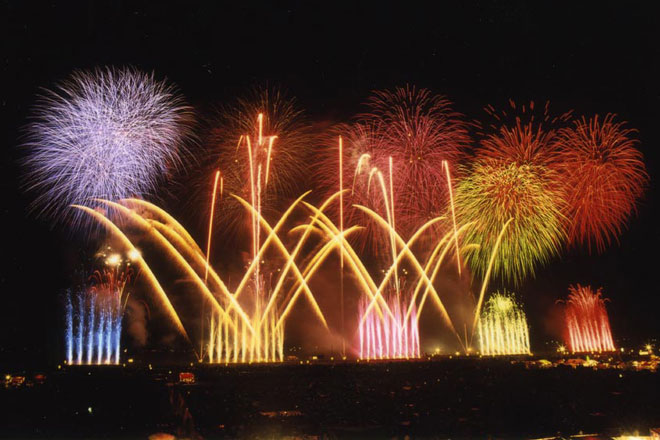
大曲の花火は、正式名称が全国花火競技大会とあるように花火師の競技会です。内閣総理大臣賞、経済産業大臣賞、文部科学大臣奨励賞、中小企業庁長官賞が授与されます。内閣総理大臣賞があるのは大曲と土浦(茨城県)の大会だけです。
伝統と格式を持つ大曲の花火は今、全国えりすぐりの花火師たちが最新の花火を持ち寄り、競い合い、会場である雄物川河川敷に約10万人の観客を集める日本有数の大イベントとなりました。
As suggested in the name National Fireworks Competition, Omagari Hanabi is a competitive contest between hanabi artists. Along with the Prime Minister’s Prize; the Economy, Trade and Industry Minister's Prize; Education, Culture, Sports, Science and Technology Minister's Prize; and the Small and Medium Enterprise Agency Director-General's Prize are awarded. The Prime Minister’s Prize is only awarded at Omagari and Tsuchiura (Ibaraki).
Today at Omagari Hanabi, steeped in tradition and prestige, the best hanabi artists in the country bring their latest pieces to compete in front of an audience of around 100,000 spectators sprawled across the riverbank at one of Japan’s largest events.
参考:『大曲の花火小史』 ”Reference: A Short History of Omagari Hanabi”
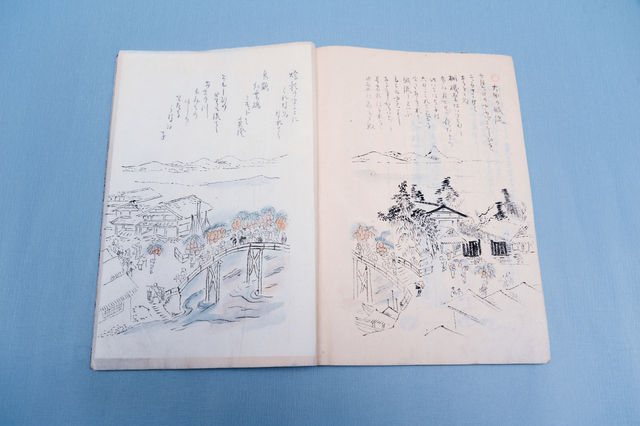
「菅江真澄遊覧記 月の出羽路 仙北郡 9巻(大仙市立大曲図書館蔵写本)」 ”Masumi Sugae Topography, Dewa Road Moon, Senboku, Volume 9 (Omagari Library Collection Manuscript)”
